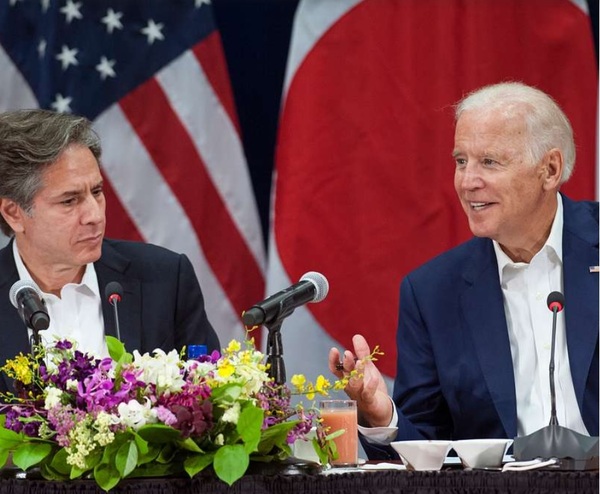
(function(d, s, id) { var js, fjs = d.getElementsByTagName(s)[0]; if (d.getElementById(id)) return; js = d.createElement(s); js.id = id; js.src = “https://connect.facebook.net/en_US/sdk.js#xfbml=1&version=v3.0”; fjs.parentNode.insertBefore(js, fjs); }(document, ‘script’, ‘facebook-jssdk’)); –>
–>
November 2, 2023
Banner headline events almost always flow from quieter real-life causes, and the worst attack on Israel in fifty years is not an exception. The coordinated raids and massacres on October 7 were possible only because of more subtle interventions over two and a half years in rooms at the State Department and the White House, with indirect help from nonprofits like the Soros-funded International Crisis Group. These interventions were driven by a small network of government and interest group insiders whose actions have gone unreported in establishment media. Though their further consequences aren’t yet clear, they’ll almost certainly involve a push to weaken both Israel and an Israeli government resistant to accords with Iran.
‘); googletag.cmd.push(function () { googletag.display(‘div-gpt-ad-1609268089992-0’); }); document.write(”); googletag.cmd.push(function() { googletag.pubads().addEventListener(‘slotRenderEnded’, function(event) { if (event.slot.getSlotElementId() == “div-hre-Americanthinker—New-3028”) { googletag.display(“div-hre-Americanthinker—New-3028”); } }); }); }
The interventions flowed from one motivation: the State Department’s determination to achieve a “reset” with Iran, restoring the consensus reached at the end of the Obama Administration through its 2015 nuclear deal. This was the main priority of high-level department staff, including Robert Malley, whose family history as well as his work at the International Crisis Group align him with pro-Iranian movers, and the recently-retired Wendy R. Sherman, whose legacy is the 2015 deal. These players, along with National Security staffer Brett McGurk, had been crucial in pushing the Obama-backed alignment with Iran. In the Biden Administration, working under Secretary of State Antony Blinken, they have had a supportive superior: a low-key gladhander who has made his career supporting whatever establishment foreign agenda is teed up for action. In this case, that foreign agenda, perhaps at the urging of ex-president Obama, has been bringing Iran back to the negotiating table by reducing Israel’s power in the region while sidelining Netanyahu, an ardent opponent of negotiations.
From Washington, these players have run a concerted effort in that direction. Peace negotiations or conversations with Iran continued consistently even as more evidence surfaced of Iranian aggression. Malley used his influence to help install a likely Iranian operative first at the State Department and then at the Pentagon — part of a larger infiltration of agents, several of whom have links to the International Crisis Group. Antony Blinken announced the American-pushed ceding by Israel of miles of potentially resource-heavy land to Lebanon, much of which is controlled by Hezb’allah, a proxy for Iran. And, in the face of August videos of Hezb’allah-trained fighters engaged in war games training, U.S. officials urged Israelis to “de-escalate” and discuss “border demarcation.”
The Administration also tried to broker a normalization proposal between Israel and Saudi Arabia that included “dealing with” the Palestinian issue: a rebuke to the Trump Administration, which had bypassed Palestinian leadership in the Abraham Accords. As occurred during the Obama Administration, Biden officials assured reporters that ‘there was ‘a common understanding’ among all the leaders in the region” that the Palestinian issue was key to normalization with Israel — despite events during the Trump Administration proving this untrue. Still, this false claim had its own strategic logic, since linking Saudi-Israel normalization to an unlikely peace with the Palestinian leadership diminished the possibility of that normalization — and kept Iran, which opposes it, at the negotiating table.
‘); googletag.cmd.push(function () { googletag.display(‘div-gpt-ad-1609270365559-0’); }); document.write(”); googletag.cmd.push(function() { googletag.pubads().addEventListener(‘slotRenderEnded’, function(event) { if (event.slot.getSlotElementId() == “div-hre-Americanthinker—New-3035”) { googletag.display(“div-hre-Americanthinker—New-3035”); } }); }); }
 Finally, there was the push in Israel proper against Netanyahu, ostensibly meant to stop Netanyahu’s coalition from limiting the discretionary powers of Israel’s Supreme Court, which even non-supportive observers think is merited after the Court’s 30-year aggrandizement of power. In practice, it meant Blinken and Biden directing heavy public criticism at Netanyahu’s government and using American funds to support protests which paralyzed the country, drawing members of its security services into politics even as they vouched for the fact that Israel’s border with Gaza was secure.
Finally, there was the push in Israel proper against Netanyahu, ostensibly meant to stop Netanyahu’s coalition from limiting the discretionary powers of Israel’s Supreme Court, which even non-supportive observers think is merited after the Court’s 30-year aggrandizement of power. In practice, it meant Blinken and Biden directing heavy public criticism at Netanyahu’s government and using American funds to support protests which paralyzed the country, drawing members of its security services into politics even as they vouched for the fact that Israel’s border with Gaza was secure.
These moves had real consequences on and after October 7. Hamas’s tactics were similar to those broadcast in the Hezb’allah wargames a few months earlier. Reports indicate that Israel’s cyber defense system was compromised — a suggestive fact when it’s backlit against Iranian permeation of American defense networks. Hezb’allah, more secure since the U.S.-backed Israel-Lebanon agreement last year, launched rockets at Israel after Hamas’s invasion. Finally, in the wake of the attack, the Palestinian “issue” is in the forefront, Netanyahu is weakened, and Iran’s hand in the region is strengthened.
Already, the Administration is pushing to maximize these results. The White House is leaking its concerns that an Israeli attack could lead to a “regional conflagration” — an early justification for limiting Israel’s response. In the face of a Wall Street Journal report alleging Iranian involvement in the planning of the attack, The New York Times reported anonymous American officials claiming that “key Iranian leaders were surprised by the Hamas attack.” Israel and the United States are gearing up for a campaign against Hamas that’s explicitly compared to its campaign against ISIL — one that in the hands of Robert Malley and Brett McGurk ended up strengthening Iran in 2015.
All the while, as explicitly pro-Hamas support surfaces and is condemned, establishment media’s rhetorical push favors neither Israel nor its government. Reports and interviews in the Times and on MSNBC have insinuated or outright argued that Gaza’s undeniably immiserated reality made the crisis inevitable. The Times has focused on the fact that “severe divisions in Israel over a judicial overhaul” encouraged the attack and gone so far as to suggest that the Abraham Accords caused the attack by antagonizing Palestinians. The New Yorker has emphasized the Netanyahu government’s lack of preparation and Palestinians’ desperation. Finally, when foreign networks in Washington do get reported on, they’re not Iran’s.
One of the reasons these narrative lines can get pushed is the selective silences of people, mostly Democrats and neoconservatives, who have long called themselves Israel’s friends but whose domestic loyalties are to the think tank and administrative nexus which helped make the attack possible: the one which effectively took power a quarter century ago and which has pushed the Middle East from one disaster to the next ever since. These establishment loyalists are ready to criticize institutions for failing to condemn support of Hamas, but not to admit that the roots of the attack on Israel go deeper: towards the heart of an establishment that has systematically made itself unaccountable to the American people and hospitable to ideologues running radicalisms inside it. Until these players acknowledge this and address it, they’re enabling it.
Matt Wolfson is an ex-leftist investigative journalist; he writes at oppo-research.com and tweets at @ex__Left.
‘); googletag.cmd.push(function () { googletag.display(‘div-gpt-ad-1609268078422-0’); }); document.write(”); googletag.cmd.push(function() { googletag.pubads().addEventListener(‘slotRenderEnded’, function(event) { if (event.slot.getSlotElementId() == “div-hre-Americanthinker—New-3027”) { googletag.display(“div-hre-Americanthinker—New-3027”); } }); }); } if (publir_show_ads) { document.write(“
Image: Defense Visual Information Distribution Service
<!–
–>
<!– if(page_width_onload <= 479) { document.write("
“); googletag.cmd.push(function() { googletag.display(‘div-gpt-ad-1345489840937-4’); }); } –> If you experience technical problems, please write to [email protected]
FOLLOW US ON
<!–
–>
<!– _qoptions={ qacct:”p-9bKF-NgTuSFM6″ }; ![]() –> <!—-> <!– var addthis_share = { email_template: “new_template” } –>
–> <!—-> <!– var addthis_share = { email_template: “new_template” } –>





